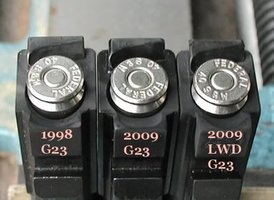dcmdon
NES Member
Re heavy vs light.
There has kindof become a bit of a misunderstanding re light vs heavy bullets as a result of people trying to make IPSC major power factor.
When trying to make power factor, many people have found that the slower recoil of a heavier bullet is preferable.
Unfortunately the internets has taken that to mean taht all heavy loads for a given caliber are lighter recoiling. That is simply not true. My 124 gr 9mm loads recoil appreciably less than my 147s. The 124s have a lower power factor. And if I tried to get the 124s up to the same power factor, they may recoil more than the 147s.
But I don't shoot IPSC. All I care is that they cycle the gun reliably. And if that is my goal, I've found I can get a lighter recoiling load with lighter bullets.
As a point of reference my loads are:
147 gr precision bullet truncated cone coated, 5.0 gr of AA5
124 gr precision delta fmj or hp, 5.6 (ish I don't have my diary in front of me) of AA5
Don
There has kindof become a bit of a misunderstanding re light vs heavy bullets as a result of people trying to make IPSC major power factor.
When trying to make power factor, many people have found that the slower recoil of a heavier bullet is preferable.
Unfortunately the internets has taken that to mean taht all heavy loads for a given caliber are lighter recoiling. That is simply not true. My 124 gr 9mm loads recoil appreciably less than my 147s. The 124s have a lower power factor. And if I tried to get the 124s up to the same power factor, they may recoil more than the 147s.
But I don't shoot IPSC. All I care is that they cycle the gun reliably. And if that is my goal, I've found I can get a lighter recoiling load with lighter bullets.
As a point of reference my loads are:
147 gr precision bullet truncated cone coated, 5.0 gr of AA5
124 gr precision delta fmj or hp, 5.6 (ish I don't have my diary in front of me) of AA5
Don

